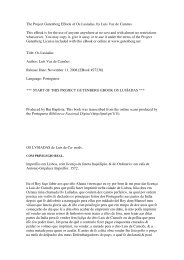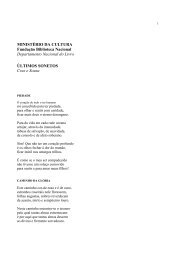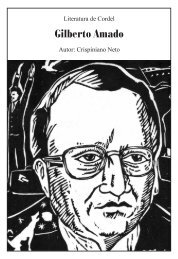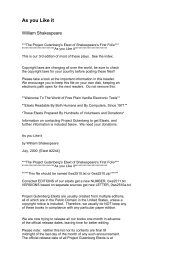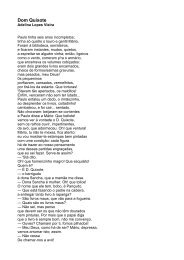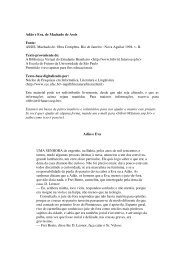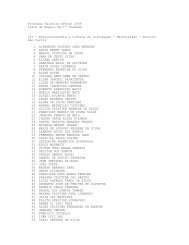Create successful ePaper yourself
Turn your PDF publications into a flip-book with our unique Google optimized e-Paper software.
Victor Hugo's conception of the scheme of the series of poems to which he gave the title<br />
of La Légende <strong>des</strong> Siècles is thus <strong>des</strong>cribed in the preface to the first scenes: 'Exprimer<br />
l'humanité dans une espèce d'oeuvre cyclique; <strong>la</strong> peindre successivement et<br />
simultanément sous tous ses aspects, histoire, fable, philosophie, religion, science,<br />
lesquels se résument en un seul et immense mouvement d'ascension vers <strong>la</strong> lumière;<br />
faire apparaître, dans une sorte de miroir sombre et c<strong>la</strong>ir—que l'interruption naturelle de<br />
travaux terrestres brisera probablement avant qu'il ait <strong>la</strong> dimension rêvée par l'auteur—<br />
cette grande figure une et multiple, lugubre et rayonnante, faible et sacrée, L'Homme.'<br />
The poet thus dreamt of a vast epic, of which the central figure should be no mythical or<br />
legendary hero, but Man himself, conceived as struggling upwards from the darkness of<br />
barbarism to the light of a visionary golden age. Every epoch was to be painted in its<br />
dominant characteristic, every aspect of human thought was to find its fitting<br />
expression. The first series could pretend to no such completeness, but the poet<br />
promised that the gaps should be filled up in succeeding volumes. It cannot be said that<br />
this stupendous <strong>des</strong>ign was ever carried out. The first volumes, which were published in<br />
1859, and from which the poems contained in this selection are taken, left great spaces<br />
vacant in the ground-p<strong>la</strong>n of the work, and little attempt was made in the subsequent<br />
series, which appeared in 1877 and 1883, to fill up those spaces. In fact, Hugo has left<br />
<strong>la</strong>rge tracts of human history untrod. He has scarcely touched the civilization of the<br />
East, he has given us no adequate picture of ancient Greece. L'Aide offerte à Majorien<br />
can hardly be regarded as a sufficient picture of the wanderings of the nations, nor Le<br />
Régiment du Baron Madruce as an adequate embodiment of the spirit of the eighteenth<br />
century. The Reformation, and, what is stranger still, the French Revolution, are not<br />
handled at all, though the heroism of the Napoleonic era finds fitting <strong>des</strong>cription in Le<br />
Cimetière d'Ey<strong>la</strong>u. The truth is that Hugo set himself a task which was perhaps beyond<br />
the power of any single poet to accomplish, and was certainly one for which he was not<br />
altogether well fitted. He did not possess that capacity for taking a broad and impartial<br />
view of history which was needed in the author of such an epic as he <strong>des</strong>igned. His<br />
strong predilections on the one hand, and his violent antipathies on the other, swayed<br />
his choice of subjects, narrowed his field of vision, and influenced his manner of<br />
presentment. The series cannot therefore pretend to philosophic completeness. It is a<br />
gallery of pictures painted by a master-hand, and pervaded by a certain spirit of unity,<br />
yet devoid of any strict arrangement, and formed on no carefully maintained principle.<br />
It is a set of cameos, loosely strung upon a thread, a structure with countless beautiful<br />
parts, which do not however cohere into any symmetrical whole. The poems are cast in<br />
many forms; allegory, narrative, vision, didactic poetry, lyric poetry, all find a p<strong>la</strong>ce.<br />
There is little history, but much legend, some fiction, and a good deal of mythology.<br />
The series was not <strong>des</strong>igned as a whole. La Chanson <strong>des</strong> Aventuriers de <strong>la</strong> Mer was<br />
written in or before 1840, Le Mariage de Ro<strong>la</strong>nd, Aymerillot, and La Conscience in or<br />
about 1846, and other pieces at intervals between 1849 and 1858, the date at which the<br />
poet appears to have begun the task of building these fragments into an epic structure.<br />
Nor is there in these poems any dispassionate attempt to portray the character of the<br />
successive ages in the life of the race. For Hugo there was no 'émancipation du moi.'<br />
The Légende is less a reve<strong>la</strong>tion of history than it is a reve<strong>la</strong>tion of the poet. His choice<br />
of themes was dictated less by a careful search after what was most characteristic of<br />
each epoch than by his own strong predilections. He loved the picturesque, the heroic,<br />
the enormous, the barbarous, the grotesque. Hence Éviradnus, Ratbert, Le Mariage de<br />
Ro<strong>la</strong>nd. He loved also the weak, the poor, the defenceless, the old man and the little<br />
child. Hence Les Pauvres Gens, Booz endormi, Petit Paul. He delighted in the<br />
monstrous, he revelled in extremes, and he had little perception of the lights and sha<strong>des</strong>




